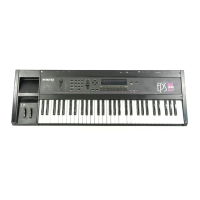Section 4 — Effects
EPS-16 PLUS Musician's Manual
Dist Gain IN/OUT — Distortion Input and Output Gain
Range: 00 to 99
The IN parameter determines the input signal gain into the amplifier simulation,
creating a tube-like overdrive.
The OUT parameter controls the output of the amplifier distortion. There is a
(fixed) clean path in parallel with the distortion. Therefore, to eliminate
distortion, set this parameter to zero.
Speaker Gain
Range: 00 to 99
Controls the level of the signal (distorted or not) applied to the rotary speaker.
High values will simulate a broken speaker. Also use higher settings when using
little or no distortion, because the distortion raises the signal level to the speaker.
Distortion Filter
A three-pole, low-pass filter following the amplifier simulation. This parameter
controls the filter cutoff, resulting in a brighter sound (for higher values) or a
darker sound (low values).
CHOR+REV+DDL
Chorus with digital delay and reverb. Assign a voice to BUS1 for Chorus and
Reverb, BUS2 for Reverb only, and BUS3 for Digital Delay.
Bus1 Rev After Chor — Reverb After Chorus
Bus2 Reverb Mix
Reverb Decay Time
Low Freq Decay — Low Frequency Decay
Hi Freq Damping — High Frequency Damping
Reverb Detune Rate/Amt
Chorus Rate/Amt
Chorus Mix
Chorus Feedback
See the descriptions under Chorus+Reverb.
DDL Time L/R
Range: 0 to 750
This parameter determines the delay time for the left and right channels
independently. Adjustable from 0 to 750 in 1 millisecond increments.
DDL Mix/Fback (Feedback)
Mix Range: 00 to 99
Feedback Range: -99 to +99
DDL Mix determines the Dry/Wet mix of the Digital Delay. The DDL Feedback
parameter controls the amount of feedback applied to the Digital Delay. The sign
of the value determines the polarity of the feedback. The feedback comes from
the right delay line only.
4 - 14
Effect Parameters

